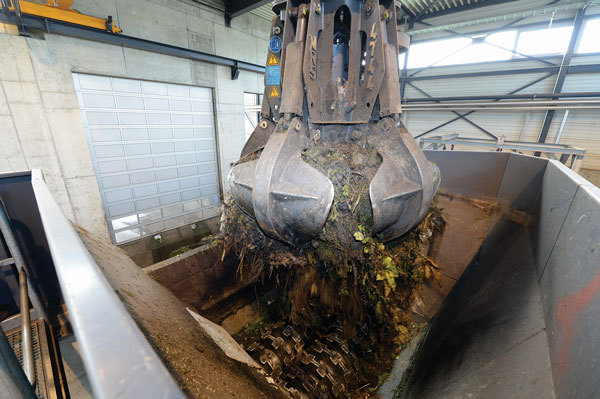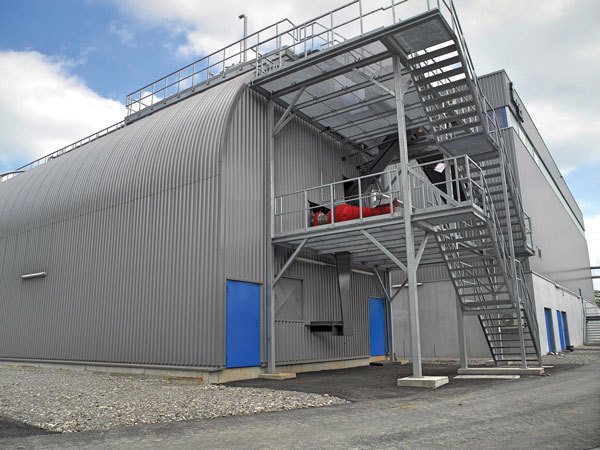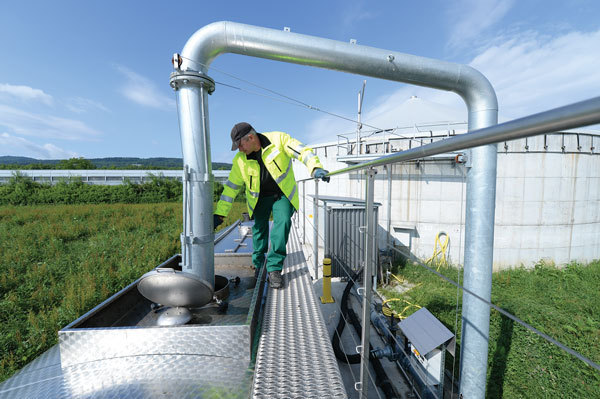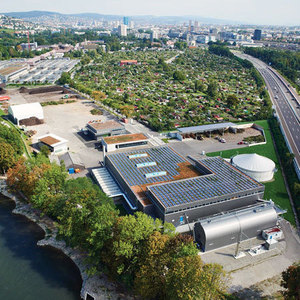From Open-Air Composting to Efficient Anaerobic Digestion













PHOTO: HITACHI ZOSEN INOVA
May 5, 2020
BY Jim McMahon
Since 1978, the city of Zurich, Switzerland has collected green waste through its recycling and waste management unit, ERZ Entsorgung+Recycling Zurich, and processed it into compost at its Werdholzli facility in western Zurich, adjacent to the city’s wastewater treatment plant along the Limmat River. The source-segregated organic municipal solid waste (MSW) is collected from the city’s 400,000 residents, businesses and from surrounding communities. It includes waste from households such as tree and lawn cuttings, and organic kitchen waste like fruits, vegetables and foodstuffs, as well as organic wastes from restaurants and food processors. Until 2013, up to 25,000 tons of organic waste was collected annually and open-air composted at the facility, which created ongoing concerns from local urban residents because of odors.
As early as 2002, the Zurich City Council began studying the odor problem, as well as a broader solution to address a better utilization of the organic wastes collected from in the city, in support of the 2,000-Watt Society. The 2000-Watt Society is an environmental vision, first introduced in 1998 by the Swiss Federal Institute of Technology in Zurich, which postulates that Swiss citizens reduce their overall primary energy usage to no more than 2,000 watts per year, per resident, by the year 2050, without lowering their standard of living.
The concept addresses the total energy consumed for the whole society, divided by the population. Two thousand watts is approximately the current world average rate of total primary energy use, whereas, Swiss usage is approximately 5,000 watts annually—still considerably lower than most industrialized nations. A component of the 2,000-Watt agenda is that carbon-based fossil fuels would be reduced to no more than 500 watts per person within 50 to 100 years. The vision was developed in response to concerns about climate change and the future availability of energy supplies.
In 2011, Biogas Zürich AG was commissioned by the Zurich City Council, with the mandate to decommission the open-air compost yard at Werdholzli, and recycle the organic waste collected from the city and outlying communities of Zurich. This would be done by constructing an enclosed anaerobic digestion process to convert the organic waste into organic high-grade fertilizer, and produce environmentally-friendly biogas to supply the city with carbon-neutral energy, in support of the 2000-Watt Society vision.
Engineering a Solution
“The plant for organic waste digestion opened in 2013 to provide environmentally friendly organic waste management, which includes production of high-quality compost, fertilizer and the recovery of biogas as an energy source,” says Helmut Vetter, managing director, Biogas Zürich AG. “The objective was to contribute to the sustainable development of the region.”
Biogas Zurich selected Kompogas’s continuous dry anaerobic digestion technology from Hitachi Zosen Inova, for its conversion of organic waste to biogas and fertilizer. ZI is a Swiss-based global engineering, procurement, constructio contractor for thermal and biological energy-from-waste plants. The idea was to build the new Kompogas anaerobic digestion facility on the former composting site at Werdhölzli, close to the wastewater treatment plant where the city already had digesters in place for sewage sludge.
“The overall energy-generation concept was to link the new Kompogas plant with the adjacent wastewater treatment works, so that the sludge from the wastewater digesters would supply thermal energy to support the operation of the Kompogas plant,” Vetter says. “In Switzerland, sewage sludge cannot be converted to fertilizer—it must be incinerated. Part of that heating energy could now be utilized to heat the Kompogas digester.”
Advertisement
Advertisement
The Kompogas continuous dry anaerobic digestion process is based on the dry digestion of solid organic waste in an oxygen-free environment. Anaerobic digestion is a multi-step biological process with four fundamental steps that include hydrolysis, acidogenesis, acetogenesis and methanogenesis.
Throughout the entire process, large organic polymers that make up biomass are broken down into smaller molecules by microorganisms. Upon completion of the anaerobic digestion process, the biomass is converted into biogas, as well as into liquid and solid digestate. The anaerobic digestion process recovers and recycles the nutrients contained in this organic material.
Biogas is composed primarily of methane and carbon dioxide, with trace amounts of hydrogen sulfide and ammonia. Typically, biogas is saturated with water vapor and may have trace amounts of hydrogen, nitrogen and oxygen. Biogas can be directly combusted, such as in a combined-heat-and-power plant, thereby generating environmentally friendly electricity and heat, which is typically fed into the public power supply or local heating network. Alternatively, the biogas can also be processed and upgraded for use as CO2-neutral vehicle fuel, or a natural gas replacement and fed into the gas grid.
“The Kompogas process uses a horizontal plug-flow digester,” says Markus Burri, senior process engineer with HZI USA. “The organic material is transported inside the digester, with the material moving horizontally through the system by feeding on the inlet side and discharging on the outlet side. A slowly-turning agitator ensures that the substrate is optimally mixed within the digester, and the biogas bubbles are permitted to vent for high-yield formation of methane. This facilitates the biological strength of the Kompogas anaerobic environment, enabling it to make maximum use of the organic waste’s energy potential.”
Uniquely to other processes, the digester creates an extremely efficient microorganism environment, which separates and optimizes the different steps of biomass degradation throughout the process, making for very stable microbiology inside the reactor. “The process recirculates approximately one-third of the digestate, rich in thermophilic microorganisms, from the output and back upfront into the digester to activate and accelerate the anaerobic digestion process of the fresh material fed into the digester,” Burri adds. “This allows a perfect adjustment of the hydrolysis and acidogenesis rate in the digester feeding section and facilitates high bioprocessing efficiency within the system.
Advertisement
Advertisement
“Conversely, with conventional anaerobic digestion, the key steps of hydrolysis, acidogenesis, acetogenesis and methanogenesis are completely mixed,” Burri continues. “Each step takes place at the same time and at the same place in the digester. This does not permit optimum conditions for the microorganisms to digest the organic material.”
If required, additional process water creates the optimal consistency for decomposition, with humidity residing around 70 percent. A specially developed heating system regulates the temperature during processing at 131 degrees Fahrenheit (55 degrees Celsius) during a retention period of approximately 14 days. The thermophilic microorganisms decompose the organic matter and produce carbon-neutral biogas. Because the digestate is completely sterilized, the system does not require any upstream pasteurization, as is the case with other anaerobic digestion solutions.
The plant’s processing thermophilic temperature of 131 degrees is considerably higher than the lower mesophilic temperature range of other anaerobic digestion facilities. The higher processing temperature ensures that spores and bacteria are eliminated, completely sanitizing the organic material during processing. And equally important, the higher temperature permits the biogas potential to be fully exploited by the time the material comes out of the digester, in effect, extracting a higher volume of carbon-neutral biogas.
High-Grade Solid and Liquid Fertilizer
The Biogas Zurich digester has a capacity to treat 25,000 tons of waste per year. After exiting the digester, a sieve screw press is used to separate the digestate into liquid and solid fractions. The solid digestate is stored and further stabilized in subsequent composting. This process allows the material to mature into top-grade compost that is collected by nurseries, market gardens and farmers for use as a soil conditioner.
The liquid fraction is pumped to a storage tank until it’s used in agriculture as an organic liquid fertilizer. Part of the press juice is fed back into the digester to directly initiate the fermentation process.
Conversion of organic waste to usable digestate not only decreases the volume of waste, it also protects the air and climate because it reduces the greenhouse gases coming from landfill, effectively delivering a closed and environmentally friendly carbon cycle.
Containment of Odors
A vital component of this project was containing the release of odors into the surrounding environment. The design of the plant ensured odors would be adequately contained within the facility. The digester itself is a completely closed system, as the process operates under anaerobic conditions. Therefore, no emissions are released into the surrounding environment by the digestion plant. To prevent the air from penetrating into the environment both the treatment hall and the composting hall are kept within enclosed structures and slightly underpressurized. All air from the buildings is treated by an acid scrubber and then led though a biofilter.
Biogas
The raw biogas from both digestion plants (biowaste and sludge digesters) is transported by pipeline to an upgrading station. By removal of trace gases hydrogen sulfide and CO2, the biogas is transformed into biomethane, which is injected into the natural gas grid. The upgrading is achieved by an amine scrubber technology, which guarantees a very low methane slip (0.1 %) and low electricity demand. “Utilizing a single upgrading facility for the two biogas plants brings a substantial financial advantage by economy of scale,” Vetter explains. “The biogas transformation system is therefore not only environmentally friendly, but also a financially viable solution.”
The raw biogas produced from the system approximates 2.2 million cubic meters annually, capable of generating 12.4 million kilowatt-hours of power.
Milestone for Zurich
With the completion of Zurich’s state-of-the-art anaerobic digestion facility for the conversion of organic waste into quality compost, liquid fertilizers and biogas, it has achieved a critical step forward in upgrading the quality of municipal services for the residents of Zurich.
“The city of Zurich has thus achieved a milestone in the sustainable supply of renewable energy to its residents,” Vetter adds. “With the Kompogas plant playing a key role, both in terms of economics and by supporting the underlying philosophy of Switzerland’s 2000-Watt vision.”
Author: Jim McMahon
Jim.mcmahon@zebracom.net
805-905-1699
Upcoming Events





